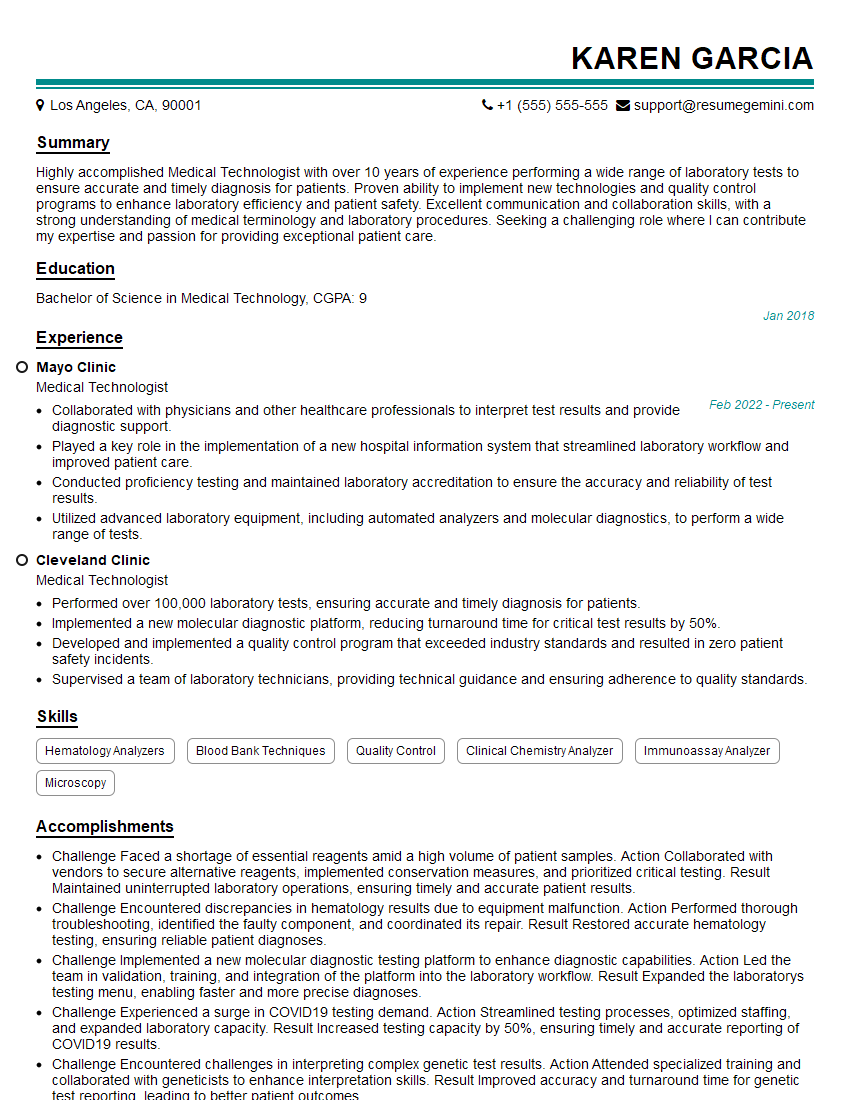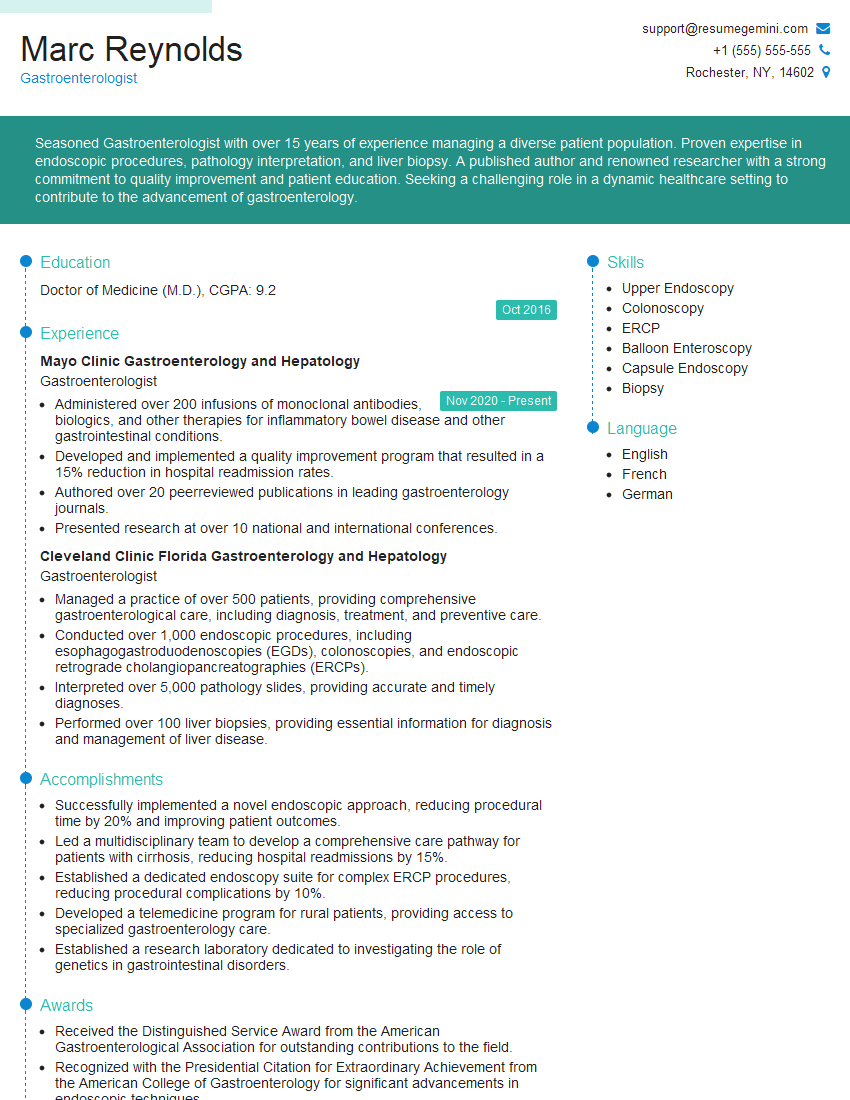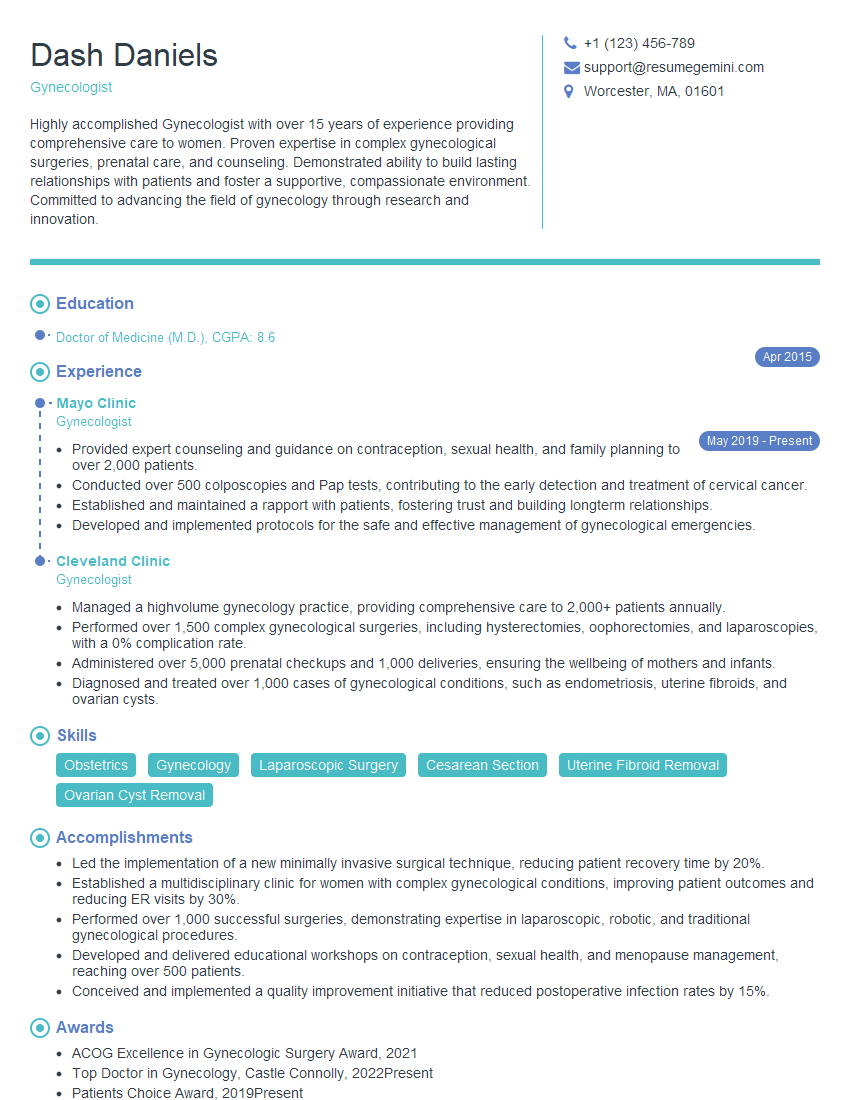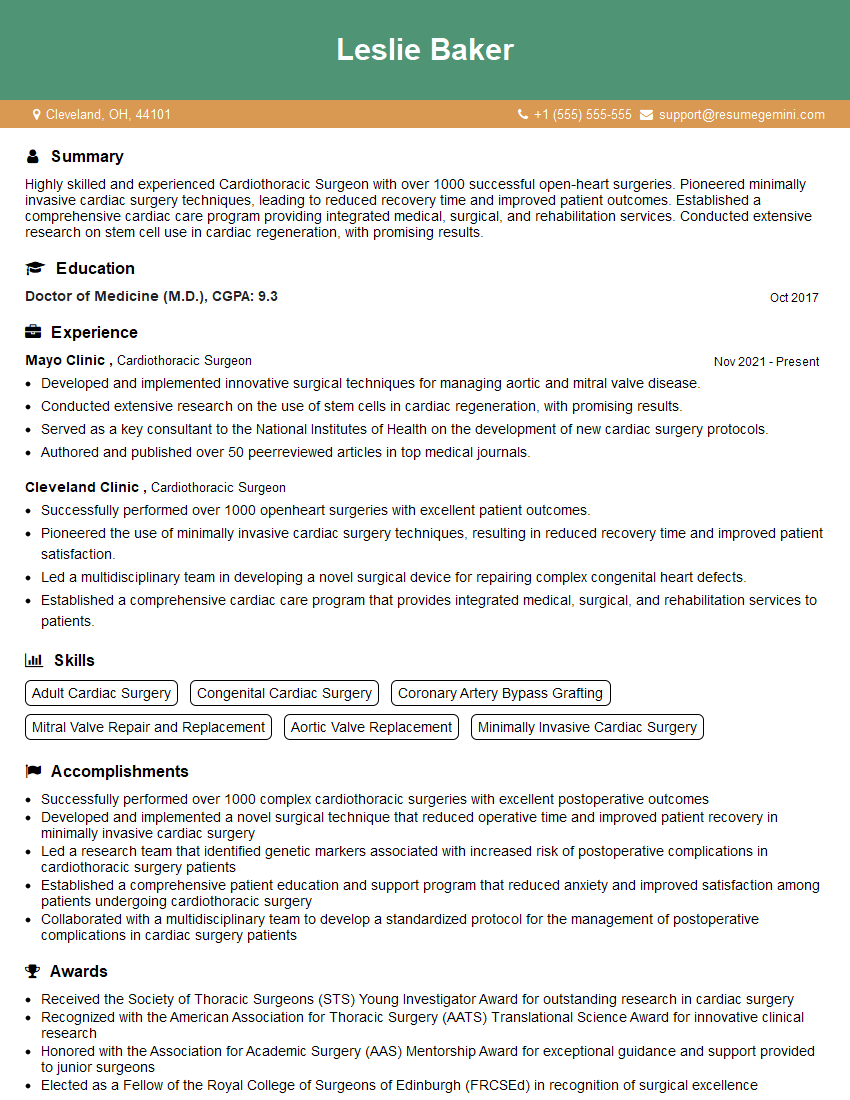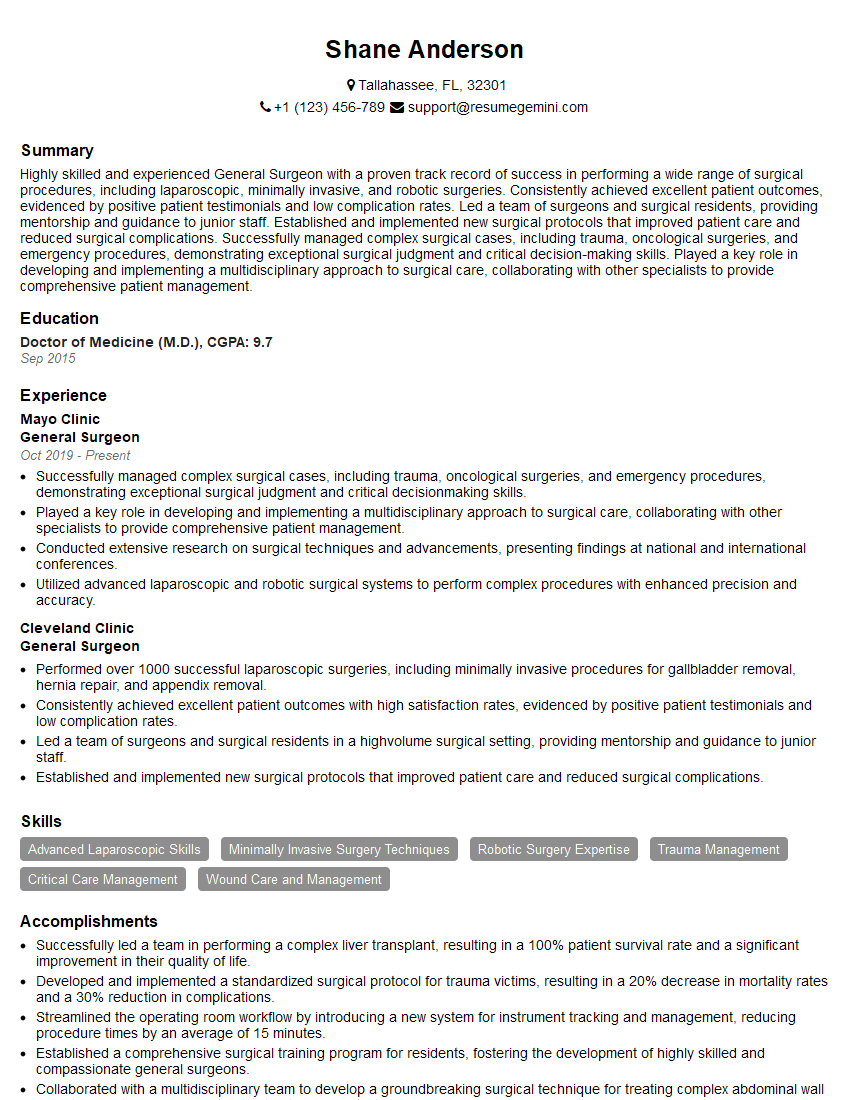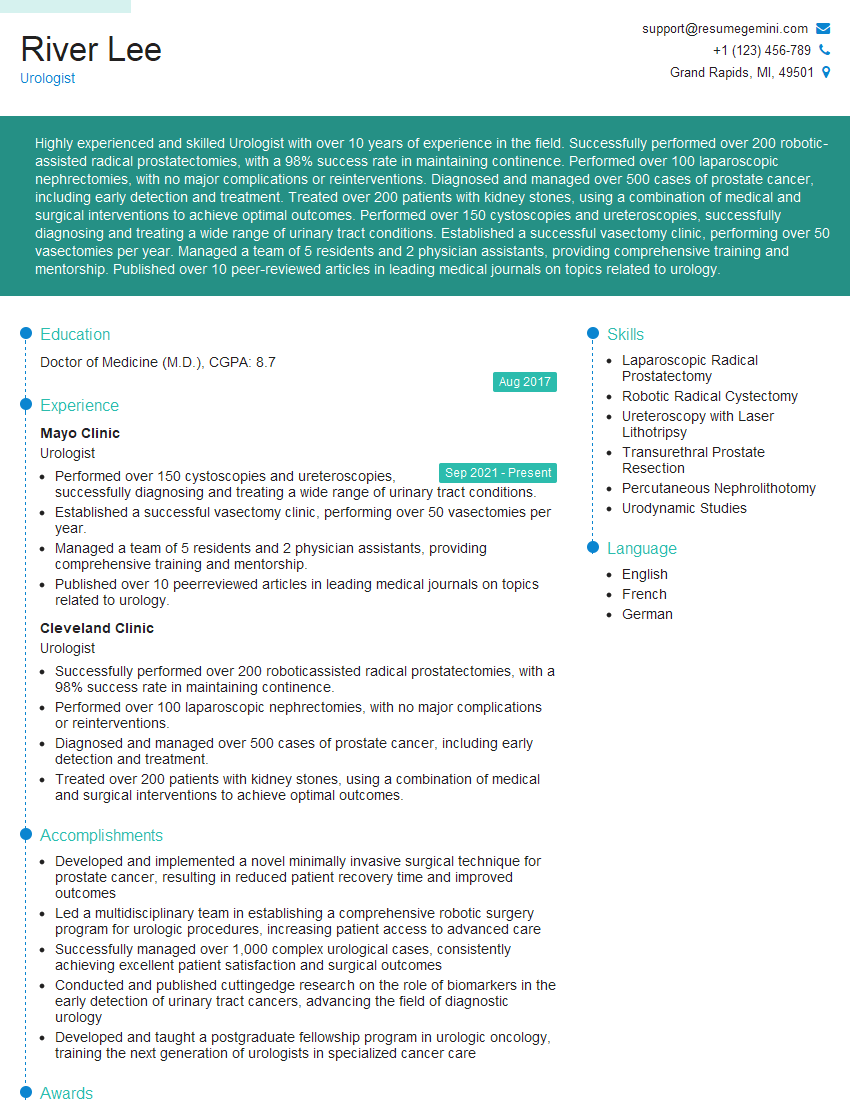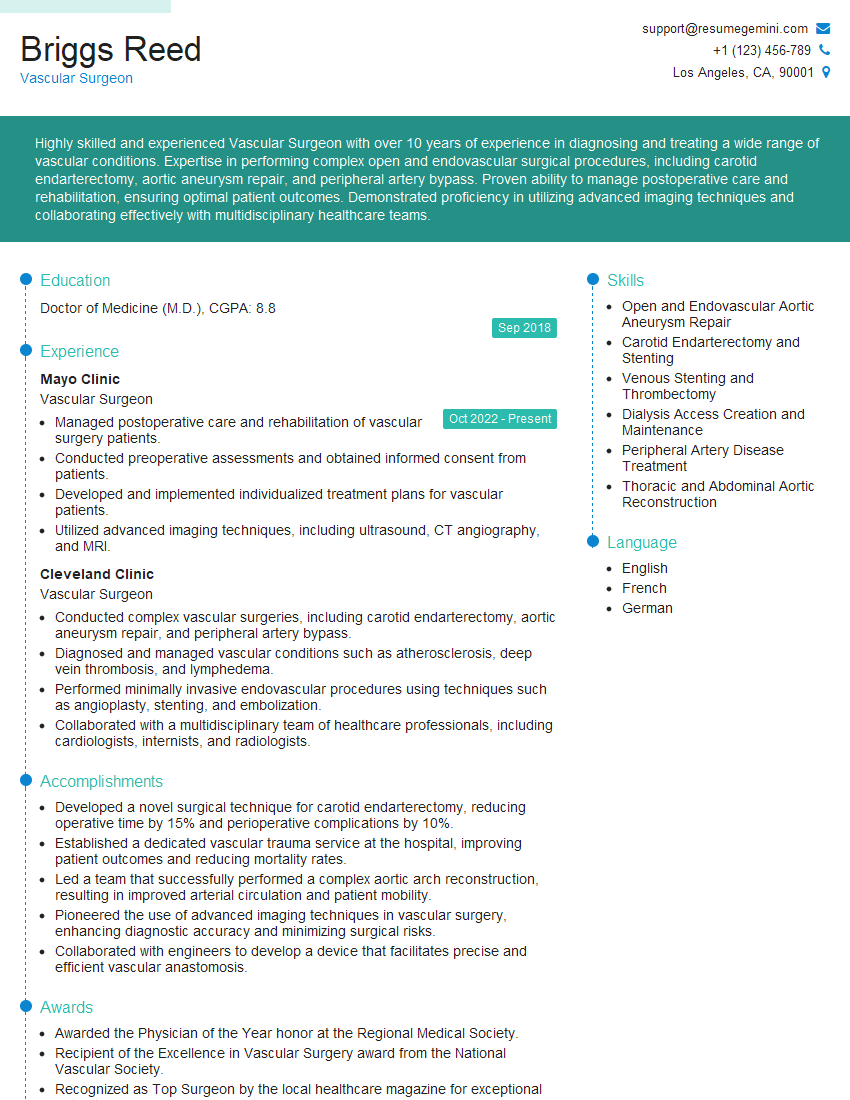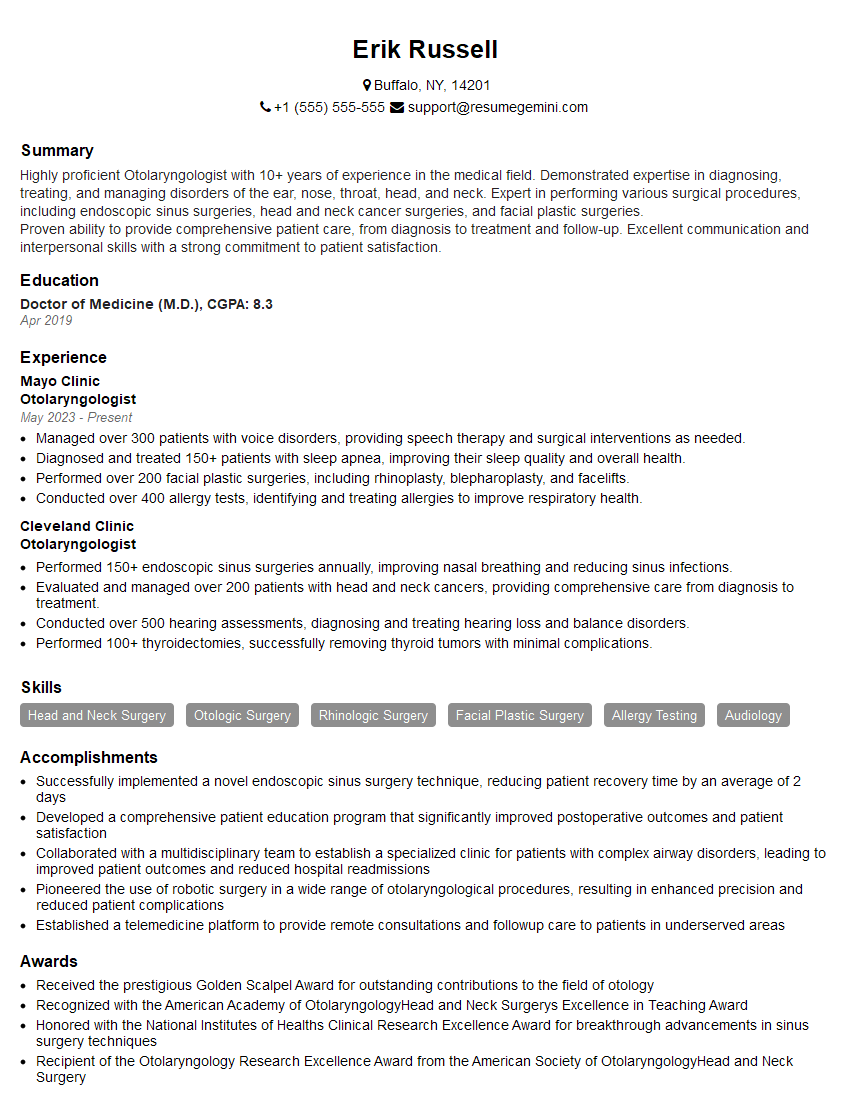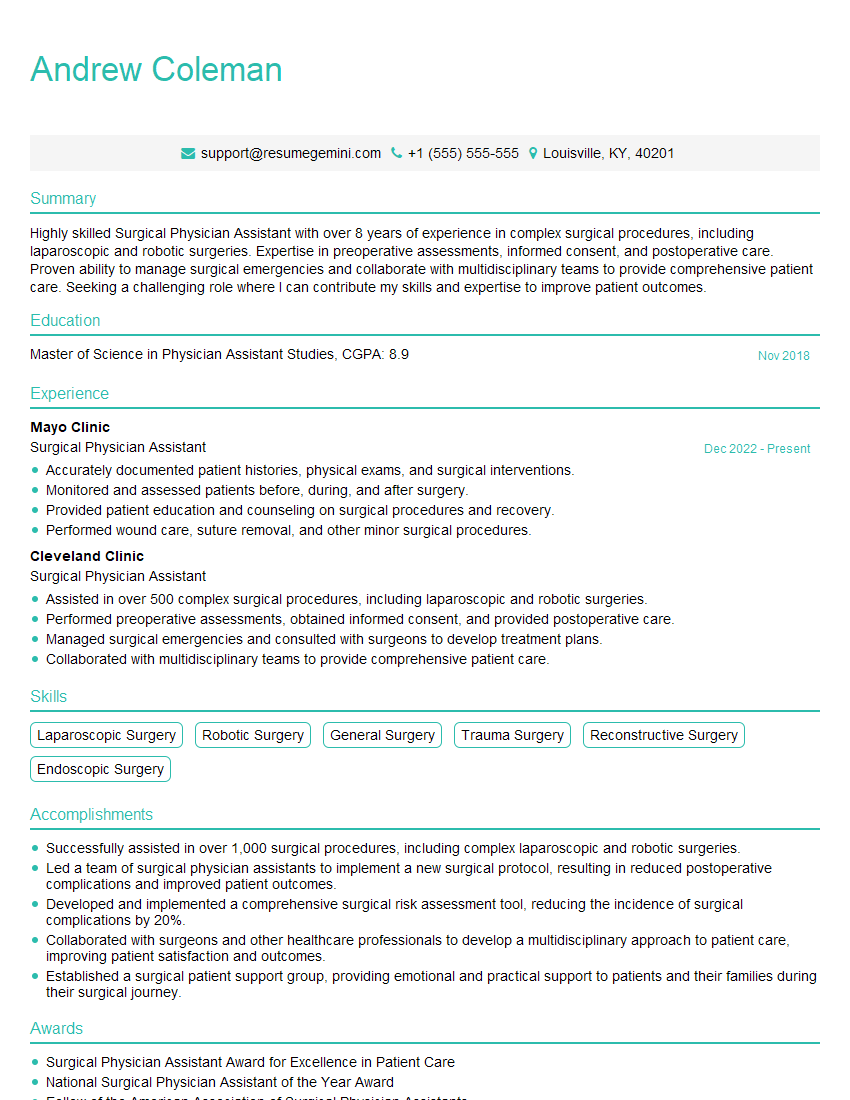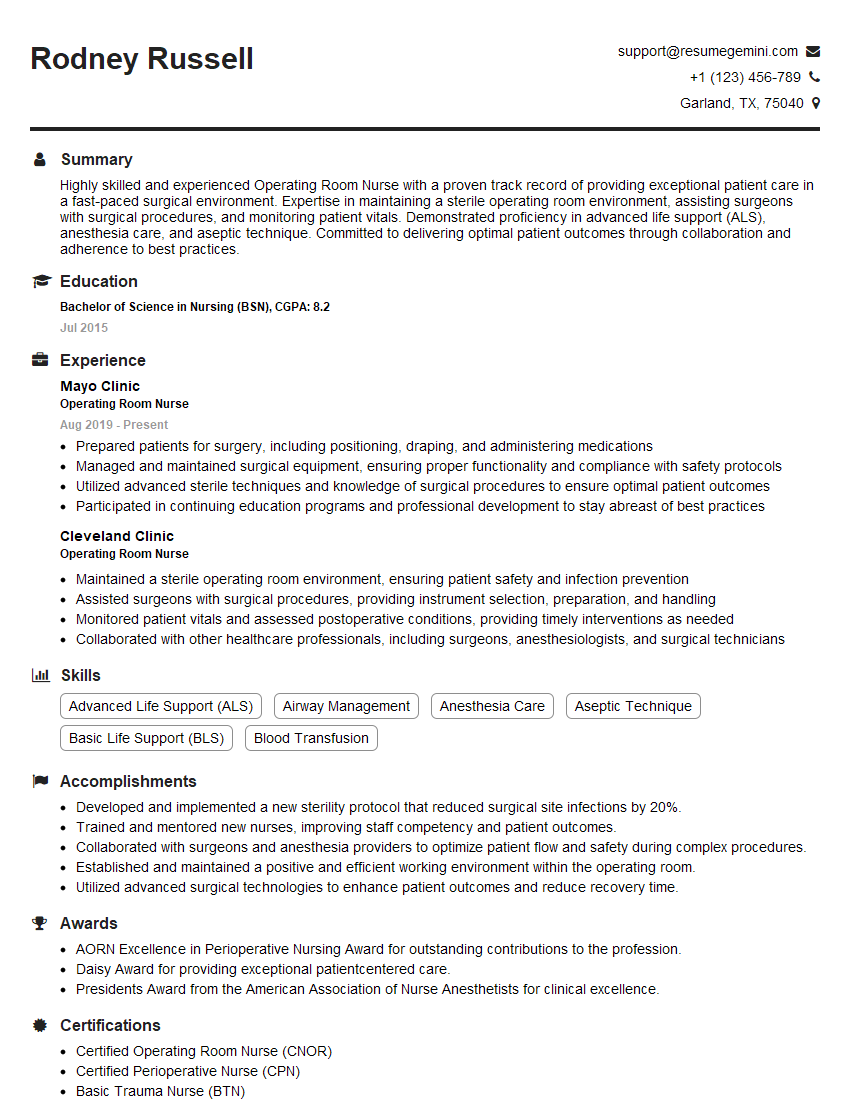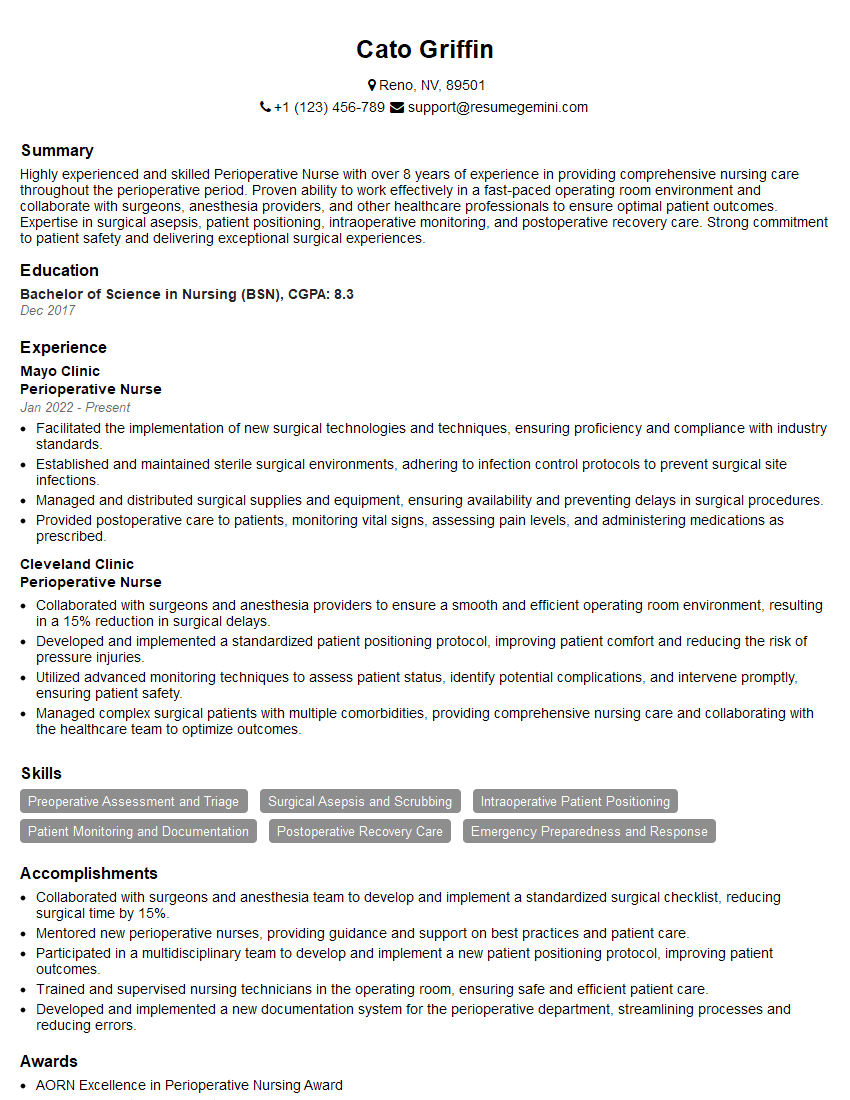Preparation is the key to success in any interview. In this post, we’ll explore crucial Cauterization interview questions and equip you with strategies to craft impactful answers. Whether you’re a beginner or a pro, these tips will elevate your preparation.
Questions Asked in Cauterization Interview
Q 1. Explain the difference between monopolar and bipolar cauterization.
The key difference between monopolar and bipolar cauterization lies in how the electrical current is delivered and completed. Think of it like this: monopolar is like using a single wire to complete a circuit, while bipolar uses two wires.
- Monopolar cauterization: Uses a single active electrode (the cautery tip) to deliver high-frequency alternating current to the tissue. The return path for the current is through a large dispersive electrode (a grounding pad) placed on the patient’s skin. This allows for larger areas of tissue to be treated but carries a higher risk of burns and current-related complications.
- Bipolar cauterization: Uses two electrodes, both active, that are very close together. The current flows directly between these two electrodes, completely contained within the surgical field. This offers improved precision and significantly reduced risk of burns outside the target area, making it ideal for delicate surgeries.
For example, monopolar cauterization might be used for extensive hemostasis during an abdominal surgery, while bipolar cauterization might be preferred for delicate procedures like neurosurgery or laparoscopic surgeries, where precise control is crucial.
Q 2. Describe the mechanism of action for electrosurgical cauterization.
Electrosurgical cauterization’s mechanism involves the conversion of electrical energy into heat energy within the targeted tissue. This heat causes desiccation (drying) and coagulation (protein denaturation) of the cells, leading to hemostasis (stopping of bleeding) and tissue destruction. The high-frequency alternating current used minimizes muscle contraction, limiting tissue trauma compared to direct current. The current’s frequency is carefully selected to optimize tissue effect and minimize complications.
Different waveforms can be selected depending on the surgical needs, such as cutting, coagulation, or a blend of both. This is achieved through varying the energy characteristics and frequency delivered by the electrosurgical unit. The type of electrode tip also significantly impacts the effect. A pointed electrode is best for cutting, while a blunt electrode provides better coagulation.
Q 3. What are the potential risks and complications associated with cauterization?
Cauterization, while a valuable surgical tool, carries potential risks and complications. These can be broadly categorized as:
- Burns: Both superficial and deep burns can occur, especially with monopolar cauterization due to stray current. This risk increases with improper grounding pad placement or inadequate gel application.
- Electrocution: Though rare with modern equipment, improper use or malfunctioning equipment can lead to electrocution, a life-threatening event.
- Bleeding: While used to control bleeding, improper technique can lead to insufficient hemostasis or even damage to blood vessels, causing further bleeding.
- Infection: Tissue damage caused by cauterization increases the risk of infection at the surgical site.
- Perfusion injury: The heat generated can damage blood vessels, leading to compromised tissue perfusion.
- Nerve damage: Cauterization near nerves can result in nerve injury, leading to loss of function, pain, or paresthesia.
- Fire hazard: The use of flammable agents and improper technique can lead to the ignition of the surgical field, causing serious complications.
The specific risk profile varies depending on several factors, including the type of cauterization used, the location and extent of the procedure, and the patient’s underlying health conditions.
Q 4. How do you select the appropriate type of cauterization for a specific procedure?
Selecting the appropriate cauterization type depends heavily on the surgical site, the nature of the procedure, and the desired tissue effect. A thorough assessment of these factors is paramount.
- Surgical Site: Delicate areas like the eye or brain necessitate bipolar cauterization to minimize collateral damage. Extensive procedures may benefit from the speed and efficiency of monopolar cauterization.
- Procedure Goals: If precise hemostasis in a small area is the goal, bipolar is preferred. If larger areas of tissue require coagulation and hemostasis, monopolar may be a better choice.
- Tissue Type: Some tissues are more sensitive to heat than others. The selection of cauterization method and settings should be tailored to the specific tissue properties.
For instance, a surgeon performing a delicate laparoscopic cholecystectomy (gallbladder removal) would likely choose bipolar cauterization to avoid damaging nearby structures, while a surgeon performing a large abdominal hysterectomy might employ monopolar cauterization for more efficient hemostasis of bleeding vessels.
Q 5. What are the safety precautions you take during cauterization?
Safety during cauterization is paramount. The following precautions are essential:
- Proper Grounding: Ensuring the patient is correctly grounded using a large dispersive electrode with ample contact gel applied to minimize the risk of burns from stray current.
- Equipment Checks: Thoroughly inspecting the electrosurgical unit, electrodes, and grounding pad before initiating the procedure to confirm functionality and prevent malfunctions.
- Irrigation: Using sterile irrigation fluid to cool the tissue and prevent excessive heat damage during cauterization.
- Low Power Settings: Starting with low power settings and gradually increasing the power as needed to minimize the risk of burns or tissue damage.
- Avoid Contact with Metal Instruments: The surgeon should avoid touching metal instruments to the electrode to prevent sparking and energy diversion.
- Patient Monitoring: Continuously monitoring the patient’s vital signs during the procedure to detect any complications early on.
Meticulous attention to these safety measures helps prevent complications and ensure the procedure’s safety.
Q 6. How do you monitor a patient during cauterization?
Continuous patient monitoring during cauterization is vital. This typically includes:
- Heart Rate and Rhythm: Monitoring the electrocardiogram (ECG) to detect any arrhythmias caused by current flow.
- Blood Pressure: Monitoring blood pressure to ensure adequate perfusion and detect any signs of shock or hemorrhage.
- Oxygen Saturation: Monitoring oxygen saturation levels (SpO2) to ensure adequate oxygenation.
- Temperature: Monitoring core body temperature to detect any signs of hyperthermia or fever.
- Surgical Site Observation: Carefully observing the surgical site for signs of excessive bleeding, burning, or other complications.
Any abnormalities detected require prompt action by the surgical team.
Q 7. What are the signs of complications during or after cauterization?
Signs of complications during or after cauterization can manifest in several ways:
- Excessive Bleeding: Unexpected or uncontrollable bleeding at the surgical site indicates insufficient hemostasis.
- Burns: The appearance of burns, either superficial or deep, at the surgical site or elsewhere on the patient’s body.
- Arrhythmias: Changes in heart rate and rhythm, such as arrhythmias or bradycardia, indicate potential current-related effects.
- Hypotension: A sudden drop in blood pressure may indicate hemorrhage or shock.
- Fever: Post-operative fever could signify infection.
- Pain and Swelling: Significant pain and swelling at the surgical site can indicate inflammation or nerve damage.
- Paralysis or Paresthesia: Numbness, tingling, or paralysis in the area around the surgical site could indicate nerve damage.
Prompt recognition and management of these signs are crucial to preventing more serious complications.
Q 8. Describe your experience with different types of electrosurgical units.
My experience encompasses a wide range of electrosurgical units (ESUs), from older, simpler models to the latest advanced systems with sophisticated features. I’ve worked extensively with both monopolar and bipolar ESUs from various manufacturers, including those with different power delivery mechanisms and waveform capabilities. For instance, I’m proficient with units offering pure cut, blend, desiccation, and fulguration modes, and I understand the nuances of adjusting power settings and waveform characteristics to achieve optimal tissue effect for diverse surgical procedures. This includes experience with both manual and foot pedal controlled units, as well as those integrated into laparoscopic systems. I’ve also worked with ESUs that incorporate advanced features such as impedance monitoring and feedback control to minimize the risk of complications.
Specifically, I’m familiar with the differences in performance and features between different brands and models, allowing me to select the optimal ESU for a particular surgical scenario. For example, in delicate procedures requiring precise coagulation, I might opt for a unit with a lower power output and fine control over the waveform, while a more robust unit with higher power output might be better suited for extensive tissue resection.
Q 9. Explain the importance of grounding pads during monopolar cauterization.
Grounding pads are absolutely crucial during monopolar cauterization. Think of it like this: the ESU sends electrical current through the patient’s body to cauterize tissue. The grounding pad provides a return path for that current. Without it, the current would have to find an alternative path, potentially through other parts of the patient’s body – causing a severe burn at the point of unintended current exit. The pad’s large surface area ensures even current distribution, minimizing the risk of burns at the pad site itself.
Proper placement is equally vital. The pad should be placed on a large, fleshy area with good blood supply, avoiding bony prominences and areas with reduced perfusion like scars or hair. Furthermore, the pad must maintain firm contact with the skin to minimize impedance, ensuring efficient current flow through the desired pathway. Failure to properly ground the patient is a serious safety hazard that can lead to patient injury and even death.
Q 10. How do you manage accidental burns during cauterization?
Accidental burns are a potential complication of cauterization. Immediate action is key. The first step is to stop the cauterization immediately. Then, the burned area needs to be assessed and treated depending on the severity. Minor burns, such as superficial reddening, typically heal on their own with minimal intervention, potentially with topical antibiotic ointment. For deeper burns with blistering or significant tissue damage, immediate cooling is essential (cold compresses for 10-15 minutes), and the burn should be assessed by a surgeon. Depending on the depth and size, further treatment might include debridement, dressings, or potentially grafting.
Preventing burns is paramount. This involves careful monitoring of the ESU settings, ensuring adequate irrigation to dissipate heat, using appropriate waveform and power settings for the tissue type, and maintaining good visual contact with the surgical site. Proper patient grounding and electrode placement are also fundamental aspects of burn prevention. Patient education and detailed post-operative instructions are also extremely important.
Q 11. What are the different types of electrosurgical waveforms?
Electrosurgical waveforms are classified based on their output and intended tissue effect. The most common types include:
- Cut: This waveform uses high-frequency, high-voltage electricity to cleanly cut through tissue by vaporizing cellular components. Think of a precise laser-like incision.
- Coagulation (Desiccation/Fulguration): This utilizes lower frequency, lower voltage electricity to cause tissue desiccation (drying) or fulguration (superficial coagulation). It creates a controlled burn to seal blood vessels. Desiccation is more precise and produces a more localized effect than fulguration.
- Blend: A combination of cut and coagulation waveforms, offering both cutting and hemostasis (bleeding control) in a single mode.
The choice of waveform depends greatly on the surgical goal and the type of tissue involved. For example, cut mode is ideal for precise incisions, while coagulation is preferred for hemostasis. Blend mode provides a balance between the two for a broader range of applications.
Q 12. Explain the concept of impedance in electrosurgery.
Impedance in electrosurgery refers to the resistance to the flow of electrical current. It’s essentially the opposition the tissue presents to the passage of the electrical current from the active electrode to the grounding pad. High impedance can lead to decreased efficiency, sparking, and the risk of burns. Think of it like trying to push water through a narrow pipe – the narrower the pipe (higher impedance), the more difficult and slower the flow.
Several factors contribute to impedance, including tissue type (e.g., dry tissue has higher impedance than moist tissue), the quality of the grounding pad contact, and the presence of desiccated or charred tissue. Modern ESUs often incorporate impedance monitoring systems to detect high impedance, alerting the surgeon to potential problems and allowing for adjustments such as increased power or better grounding contact. This is an important safety feature aimed at preventing complications.
Q 13. How do you troubleshoot common problems encountered with electrosurgical devices?
Troubleshooting ESUs requires a systematic approach. Common issues include:
- No output: Check power source, electrode connection, and unit settings.
- Sparking/Arcing: Investigate the impedance (poor grounding, desiccated tissue), electrode condition, and adjust the power settings.
- Ineffective coagulation: Examine impedance, electrode placement, adjust coagulation settings (power, waveform), and ensure adequate tissue contact.
- Burns at the grounding pad: Assess the placement and contact, and ensure a good, large surface area with good blood flow. Consider repositioning.
Many ESUs have self-diagnostic capabilities that can pinpoint the problem. If the issue persists after checking these aspects, it is crucial to contact a biomedical engineer for professional service and repair to ensure patient safety.
Q 14. What is the role of irrigation during cauterization?
Irrigation plays a crucial role during cauterization, especially during monopolar procedures. It serves multiple vital functions:
- Cooling: Irrigation helps dissipate heat generated during cauterization, reducing the risk of thermal injury to surrounding tissues. Think of it as a cooling system preventing overheating.
- Improved visualization: Irrigation clears away smoke and debris produced during the procedure, improving the surgeon’s visibility of the surgical field. This aids precision and safety.
- Reduced impedance: Irrigating the tissue with saline solution helps reduce impedance, ensuring efficient current flow and reducing the risk of sparking or arcing.
- Removal of charred tissue: Irrigation helps to remove and flush away the charred debris created during cauterization, ensuring better visibility and potentially facilitating better healing.
The type and volume of irrigation fluid will depend on the specific procedure and the surgeon’s preference. However, proper irrigation technique is a fundamental component of safe and effective cauterization.
Q 15. Describe your experience with different types of cautery tips/electrodes.
My experience encompasses a wide range of cautery tips and electrodes, each suited for specific applications. For example, monopolar cautery often utilizes various shapes of electrodes – ball-tipped, needle-tipped, and loop electrodes – depending on the tissue being targeted and the desired effect. Ball-tipped electrodes are excellent for broad coagulation, while needle-tipped ones provide precise hemostasis in smaller areas. Loop electrodes are frequently used for resection of larger tissues. Bipolar cautery, on the other hand, uses forceps with two prongs, minimizing the risk of unintended burns by localizing the current. I’m also proficient with specialized electrodes like those designed for specific surgical procedures, such as those used in laparoscopic surgery or for specific areas like the nasal passages. The choice of electrode is critical, directly influencing the precision and effectiveness of the cauterization.
Furthermore, I have extensive experience with the use of different materials for electrodes. For instance, I’m familiar with the properties of various metals used in electrodes and how their conductive capabilities influence the effectiveness of the cautery procedure. The selection of the appropriate electrode material is crucial to avoid issues such as electrode corrosion and reduced performance.
Career Expert Tips:
- Ace those interviews! Prepare effectively by reviewing the Top 50 Most Common Interview Questions on ResumeGemini.
- Navigate your job search with confidence! Explore a wide range of Career Tips on ResumeGemini. Learn about common challenges and recommendations to overcome them.
- Craft the perfect resume! Master the Art of Resume Writing with ResumeGemini’s guide. Showcase your unique qualifications and achievements effectively.
- Don’t miss out on holiday savings! Build your dream resume with ResumeGemini’s ATS optimized templates.
Q 16. How do you maintain sterile technique during cauterization?
Maintaining sterile technique during cauterization is paramount to prevent infection. This starts with meticulous hand hygiene, followed by the use of sterile gloves, gowns, drapes, and instruments. The surgical site is prepared with an antiseptic solution to eliminate surface bacteria. All cautery equipment is properly sterilized before use, and the electrode is changed between patients or procedures as necessary. Throughout the procedure, a conscious effort is made to minimize contamination, including limiting the number of personnel in the sterile field and carefully handling instruments to prevent accidental contamination. Following the procedure, all used instruments are properly disposed of or decontaminated and re-sterilized.
Think of it like building a house – if the foundation isn’t sterile, the entire structure (the procedure) is compromised. We meticulously prepare every stage to ensure safety.
Q 17. What are the advantages and disadvantages of using different cautery settings?
Different cautery settings impact the outcome significantly. Lower settings, such as those used for coagulation, produce gentle heat, ideal for sealing small blood vessels. This minimizes tissue damage but may require more time. Conversely, higher settings, used for cutting, deliver intense heat to rapidly cut through tissue. This is faster but carries a higher risk of collateral damage and charring. The choice depends on the surgical goal. For example, during a delicate procedure like removing a benign skin lesion, a lower coagulation setting is preferred to minimize scarring. Conversely, a higher cutting setting is more suitable for a surgical resection where speed is needed, though tissue damage needs careful management.
Imagine it like using a cooking flame: a low flame simmers, while a high flame boils quickly – each has a place depending on the outcome.
Q 18. Describe your experience with laser cauterization.
Laser cauterization provides a highly precise and controlled method of tissue ablation and hemostasis. I have extensive experience using different types of lasers including CO2 and Nd:YAG lasers. CO2 lasers offer excellent precision and are often preferred for superficial lesions or delicate procedures, while Nd:YAG lasers penetrate deeper and are better suited for treating lesions beneath the surface of the skin. Laser cauterization minimizes thermal spread, thereby reducing collateral damage. However, the use of laser cauterization also mandates an understanding of its specific safety precautions, including the need for appropriate eye protection for both the surgeon and the patient, and a deep understanding of the laser’s output parameters and tissue interactions. Safety protocols are critically important to avoid potential complications such as accidental burns or eye damage.
The precision of laser cauterization is remarkable, like using a scalpel with a very fine point, minimizing collateral damage.
Q 19. How do you handle emergencies during cauterization?
Emergencies during cauterization are rare but require immediate and decisive action. The most common emergencies involve burns, bleeding, or equipment malfunction. For burns, immediate cooling and appropriate wound management are essential. If bleeding occurs, direct pressure and potentially the use of additional hemostatic agents may be necessary. In case of equipment malfunction, such as the cautery unit failing, immediate switching to a backup unit or other hemostatic techniques is crucial to maintain patient safety. Effective communication with the surgical team is vital to ensure coordinated and efficient response in any emergency situation.
Having a clear plan of action and the ability to think on your feet is vital, much like a firefighter’s response to an emergency.
Q 20. Explain the post-cauterization care instructions for patients.
Post-cauterization care instructions vary depending on the procedure and the site of cauterization. However, general guidelines usually involve keeping the area clean and dry, changing dressings as needed, and using prescribed medications such as antibiotics or pain relievers. Patients are often advised to avoid strenuous activities, excessive heat, or direct sunlight on the treated area to aid in healing. The wound should be monitored regularly for signs of infection, such as increased pain, redness, swelling, or pus formation. Patients should be instructed to seek immediate medical attention if any of these signs appear. Thorough and clear communication with the patient is vital for a successful post-operative recovery.
Clear and comprehensive instructions to patients ensure they have a smooth recovery and can recognize potential complications.
Q 21. What are the contraindications for cauterization?
Cauterization has several contraindications, primarily involving patients with cardiac pacemakers or other implanted electronic devices due to the risk of interference from the electrical current. Patients with bleeding disorders or those on anticoagulant medications also present higher risks due to increased bleeding potential. Additionally, cauterization should be avoided in areas with compromised circulation or in the presence of active infection. The patient’s overall health status and any potential allergies to medications used during the procedure must be carefully considered. A thorough medical history and evaluation are crucial before proceeding with any cauterization procedure.
Careful consideration of contraindications prevents unforeseen risks and ensures patient safety.
Q 22. How do you document the cauterization procedure?
Accurate documentation of a cauterization procedure is crucial for patient safety and legal compliance. My documentation meticulously follows a standardized format, ensuring all relevant information is captured. This includes the patient’s demographics and medical history, the type of cauterization performed (e.g., monopolar, bipolar, radiofrequency), the site of cauterization, the energy settings used, the duration of the procedure, and a description of any complications or adverse events. I always note the type of anesthetic used, if any, and the patient’s response to the procedure. Post-procedure observations, such as bleeding, swelling, or pain, are also meticulously recorded. Finally, I include my signature and date, confirming the accuracy and completeness of the documentation. Think of it like a detailed recipe – every step is important to ensure a successful and safe outcome. For example, if a patient experienced unexpected bleeding during a monopolar cauterization of a nasal polyp, I would detail the adjustments made to the energy settings, any additional hemostasis techniques employed, and the patient’s response to those interventions.
Q 23. Describe your experience with different types of tissue reactions to cauterization.
Tissue reactions to cauterization vary greatly depending on the type of energy used, the power settings, and the tissue itself. For example, delicate tissues like the mucous membranes might exhibit mild erythema (redness) and edema (swelling) after low-energy cauterization. On the other hand, higher energy settings, particularly with monopolar cauterization, can cause more significant tissue damage, resulting in eschar (a dark crust) formation, scarring, and potentially perforation. I’ve seen instances where improperly applied high-frequency current led to significant charring, requiring additional surgical intervention. In contrast, bipolar cauterization generally produces less thermal damage, resulting in quicker healing. Understanding these varying reactions allows me to adjust the energy settings and technique accordingly to minimize complications and achieve the desired hemostasis. I always carefully monitor the tissue response during and after the procedure and adjust my technique as needed.
Q 24. How do you ensure patient safety during cauterization?
Patient safety is paramount during any cauterization procedure. My approach begins with a thorough assessment of the patient’s medical history and current condition to identify any potential contraindications, such as bleeding disorders or the use of anticoagulants. I ensure proper grounding and the use of appropriate safety equipment, such as grounding pads for monopolar cauterization. This is critical to prevent inadvertent burns to the patient. Before commencing the procedure, I explain the process clearly to the patient, answering any questions they have to alleviate anxieties. I constantly monitor the patient’s vital signs throughout the procedure and remain vigilant for signs of complications, such as excessive bleeding, tissue damage, or electrical burns. The use of appropriate energy settings is crucial – too much energy can cause significant damage, whereas too little can be ineffective. Regular calibration of the equipment is also vital for safety and efficacy. It’s like driving a car – knowing your vehicle and maintaining it regularly keeps you and your passenger safe.
Q 25. Explain your understanding of the different types of energy sources used in cauterization.
Several energy sources are used in cauterization, each with its own advantages and disadvantages.
- Monopolar cauterization uses a high-frequency alternating current delivered through a single electrode to the target tissue, with the return path through a dispersive electrode (grounding pad). It’s effective for achieving hemostasis over larger areas but carries a higher risk of burns.
- Bipolar cauterization uses two electrodes, one for delivery and one for return. The current is localized between the two electrodes, reducing the risk of burns and allowing for more precise coagulation in delicate areas.
- Radiofrequency (RF) cauterization uses radio waves to generate heat, leading to tissue desiccation and hemostasis. It often offers better control and less collateral damage compared to monopolar cauterization.
- Ultrasound cauterization uses high-frequency ultrasound waves to generate heat, achieving hemostasis with minimal damage to surrounding tissues.
Q 26. How do you address patient concerns and anxieties related to cauterization?
Addressing patient concerns and anxieties is a critical aspect of providing safe and effective cauterization. I initiate this by establishing a trusting rapport, listening attentively to their concerns, and explaining the procedure in simple, easy-to-understand terms. I answer all their questions honestly and thoroughly, addressing their fears regarding pain, scarring, and potential complications. I emphasize the benefits of the procedure, its role in resolving their medical issue, and the steps I’ll take to ensure their comfort and safety. In many cases, a brief demonstration of the equipment and a discussion of the expected sensations during the procedure can significantly reduce their anxieties. For instance, if a patient expresses fear of pain, I might discuss the use of local anesthetic or pain management strategies post-procedure. A calm and reassuring demeanor is crucial to alleviate their fears and build confidence in the process. Remember, empathy and effective communication are vital.
Q 27. What are the different types of hemostasis techniques used in conjunction with cauterization?
Several hemostasis techniques are used in conjunction with cauterization to achieve optimal bleeding control. These often complement cauterization rather than replace it.
- Direct pressure: Applying direct pressure to the bleeding site using gauze or other suitable material is a fundamental technique that can be used before, during, or after cauterization.
- Sutures: Stitches can help close wounds and control bleeding, often used in conjunction with cauterization to secure the area post-coagulation.
- Ligatures: Tying off bleeding vessels with surgical thread provides effective hemostasis for larger vessels.
- Sponges: Absorbent sponges help soak up blood and provide visual clarity during the procedure, and can facilitate better cauterization.
- Fibrin sealants: These biological adhesives are applied topically to promote clotting and assist in wound healing.
Q 28. Describe your knowledge of alternative techniques to cauterization for achieving hemostasis.
Alternatives to cauterization for achieving hemostasis exist, and the choice depends on the clinical situation.
- Surgical ligation: Directly tying off bleeding vessels is a precise method, particularly suitable for larger vessels.
- Clip application: Small titanium clips can be applied to seal bleeding vessels, offering a minimally invasive option.
- Topical hemostatic agents: Several agents, such as cellulose or collagen-based materials, promote clotting at the bleeding site.
- Cryotherapy: Using extreme cold to freeze and destroy tissue can achieve hemostasis, especially in superficial lesions.
Key Topics to Learn for Cauterization Interview
- Types of Cauterization: Understand the differences between monopolar, bipolar, and radiofrequency cauterization, including their mechanisms and applications.
- Equipment and Instrumentation: Familiarize yourself with the various devices used in cauterization procedures, their functionalities, and safety precautions.
- Surgical Applications: Explore the diverse surgical applications of cauterization, from hemostasis to tissue destruction, across various specialties.
- Tissue Effects and Complications: Gain a thorough understanding of the effects of cauterization on different tissues and the potential complications, including burns, perforation, and unintended damage.
- Patient Selection and Preparation: Learn the criteria for selecting appropriate patients for cauterization and the necessary pre- and post-operative procedures.
- Safety Protocols and Risk Management: Master the essential safety protocols to minimize risks and manage potential complications during and after cauterization procedures.
- Monitoring and Post-Operative Care: Understand the importance of monitoring patients after cauterization and the appropriate post-operative care strategies.
- Troubleshooting and Problem-solving: Develop your ability to identify and address potential problems during cauterization procedures, such as equipment malfunctions or unexpected complications.
- Ethical Considerations: Understand the ethical implications of cauterization, including informed consent and patient autonomy.
Next Steps
Mastering cauterization techniques and related knowledge is crucial for career advancement in the medical field, opening doors to specialized roles and increased professional recognition. To maximize your job prospects, it’s essential to present your skills and experience effectively. Creating an ATS-friendly resume is key to ensuring your application gets noticed. ResumeGemini can help you build a professional, impactful resume that highlights your cauterization expertise. Examples of resumes tailored to Cauterization are available to guide you through the process.
Explore more articles
Users Rating of Our Blogs
Share Your Experience
We value your feedback! Please rate our content and share your thoughts (optional).
What Readers Say About Our Blog
Hello,
We found issues with your domain’s email setup that may be sending your messages to spam or blocking them completely. InboxShield Mini shows you how to fix it in minutes — no tech skills required.
Scan your domain now for details: https://inboxshield-mini.com/
— Adam @ InboxShield Mini
Reply STOP to unsubscribe
Hi, are you owner of interviewgemini.com? What if I told you I could help you find extra time in your schedule, reconnect with leads you didn’t even realize you missed, and bring in more “I want to work with you” conversations, without increasing your ad spend or hiring a full-time employee?
All with a flexible, budget-friendly service that could easily pay for itself. Sounds good?
Would it be nice to jump on a quick 10-minute call so I can show you exactly how we make this work?
Best,
Hapei
Marketing Director
Hey, I know you’re the owner of interviewgemini.com. I’ll be quick.
Fundraising for your business is tough and time-consuming. We make it easier by guaranteeing two private investor meetings each month, for six months. No demos, no pitch events – just direct introductions to active investors matched to your startup.
If youR17;re raising, this could help you build real momentum. Want me to send more info?
Hi, I represent an SEO company that specialises in getting you AI citations and higher rankings on Google. I’d like to offer you a 100% free SEO audit for your website. Would you be interested?
Hi, I represent an SEO company that specialises in getting you AI citations and higher rankings on Google. I’d like to offer you a 100% free SEO audit for your website. Would you be interested?
good
